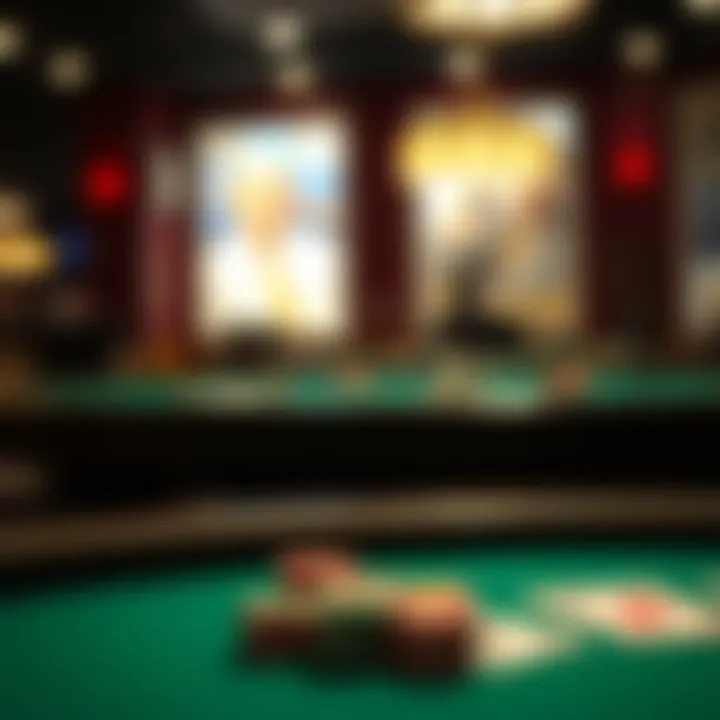The Integral Role of the Poker Table Rail in Gameplay and Design


Intro
In the world of poker, much emphasis is often placed on the flair of the game—its bluffs, bets, and potential winnings. But hidden in plain sight is an often underestimated element: the poker table rail. This strip of cushioning and design extends beyond mere aesthetics; it plays a pivotal role in the gameplay experience and the psychological comfort of players. With every hand dealt and every chip moved, the poker table rail interacts with players, fostering a connection among them while providing vital support for comfort and strategy.
As we delve into the intricacies of the poker table rail, we step into a world where design meets functionality. It is this intersection that shapes not just the physical space of poker games, but also aids in influencing betting strategies and social interactions at the table. This text will shed light on various aspects of the poker table rail. From its contribution to player comfort, to how it dynamically alters gameplay strategies, we aim to give players and enthusiasts alike a fresh perspective on what often goes unnoticed. The following sections will dissect key elements, culminating in insights that enrich the overall poker experience.
Understanding the Poker Table Rail
The poker table rail is more than just a band that surrounds the edges of a table. It serves as a fundamental element, both in terms of physical design and the overall experience of the game. Understanding this component is crucial for players and designers alike.
The rail’s design incorporates several considerations that enhance player comfort, while simultaneously reflecting the aesthetic preferences of a given space. For instance, a well-padded rail can provide a more enjoyable experience during long games, minimizing discomfort during play. This comfort isn’t merely a luxury; it can significantly impact concentration and performance at the table.
Beyond physical attributes, the poker table rail plays a role in social interaction among players. Its presence can dictate how players engage with one another, potentially fostering camaraderie or tension, depending on the game's dynamics. An inviting rail might encourage chatter, while a more austere one could create an environment more suited to intense competition.
Thus, grasping the significance of the poker table rail involves recognizing how it intertwines with both gameplay and interpersonal relationships, crafting an experience that extends far beyond mere mechanics of play.
Definition and Purpose
The definition of a poker table rail is straightforward. It is the cushioned edge that goes around the perimeter of the table, designed primarily for the comfort of players. Its primary purpose is to offer support to players’ arms and forearms while they are making bets or engaging in gameplay. Features such as soft padding, ergonomic designs, and moisture-wicking materials can greatly enhance comfort levels.
Moreover, the rail serves several other practical purposes. It acts as a barrier to keep cards and chips from falling off the table, contributing to a more organized gameplay environment. This aspect is particularly important in high-stakes games where the environment needs to be as controlled as possible.
Additionally, the rail can be a canvas for customization. From unique patterns to branding, it allows casinos and home game enthusiasts to imprint their personality onto the gameplay experience.
Historical Evolution
The historical evolution of the poker table rail reflects broader changes in gaming culture. Early poker tables often lacked any significant rail, which made for a less comfortable experience. As poker grew in social importance—especially during the mid-to-late 20th century—the introduction of the rail marked a shift towards a more player-centric design. Initially, these rails were utilitarian; largely wooden structures without much thought given to player comfort.
However, as the popularity of poker surged, especially with the rise of televised tournaments in the 1990s, manufacturers began to understand that a well-crafted rail was essential to attracting players. Today, it’s not just about comfort but also about aesthetics and functionality. Casinos and online platforms now offer a range of designs, from luxurious padded rails to sleek minimalist edges that cater to diverse tastes and preferences.
In summation, the historical journey of the poker table rail illustrates not only the evolution of the game itself but also the changing expectations of players. As poker continues to adapt and grow, the table rail remains a vital component in shaping both the immediate gameplay experience and the atmosphere surrounding the game.
Design Elements of Poker Table Rails
The design elements of poker table rails play a vital role in creating an engaging and functional gameplay environment. They are not just about aesthetics; they contribute significantly to the overall experience—both from a practical and psychological standpoint. The right design enhances player comfort, fosters communication among players, and can even influence betting behaviors during the game. This section will delve into the materials used, along with the various shapes and sizes available, shedding light on their importance in the broader context of poker gameplay.
Materials Used
Wood
Wood has long been the traditional choice for poker table rails, and for good reason. Its natural beauty brings a touch of class to any table, making it a timeless selection that many players prefer. One of the key characteristics of wood is its sturdiness. A well-built wooden rail offers solid support, while its texture provides a comfortable resting place for players' arms. As a result, players can focus more on the game rather than dealing with discomfort.
A unique feature of wood is its ability to absorb sound, which contributes to a quieter and more immersive atmosphere during gameplay. Moreover, wood can be customized with various finishes, allowing for personal touches that can resonate with a player's style or preferences. However, wood does have its disadvantages, such as susceptibility to scratches and stains if not properly maintained. This makes it imperative for owners to practice regular upkeep if they want to preserve the wood's integrity over time.
Plastic
Plastic is another popular material that is making strides in the poker world. Its lightweight nature is one of the key characteristics setting it apart from wood or metal. Players often find plastic rails easier to handle, especially in home setups where mobility is a factor. Additionally, plastic’s resistance to moisture makes it an attractive option for outdoor settings, where wood might warp or degrade over time.
One unique feature of plastic poker table rails is the variety of colors and designs available, allowing players to choose options that match their personal aesthetics. This makes it versatile for casual home games or themed parties. However, there are drawbacks to consider, such as a reduced sense of luxury compared to wood, and plastic may not feel as comfortable to rest on for prolonged periods. This tradeoff means players need to carefully consider what aspects matter most in their gaming experience.
Metal
Metal table rails introduce a modern, industrial vibe that appeals to many enthusiasts. The durability of metal cannot be overstated; it is robust and can withstand the wear and tear often associated with regular gaming sessions. This makes it a popular choice for professional environments like casinos where tables face high levels of use.
One standout feature of metal is its ability to be engineered into various shapes and sizes, which can contribute to innovative and eye-catching designs. Players often appreciate the sleek feel of metal against their arms, adding to the overall aesthetic of the table. However, a notable disadvantage is that metal can be quite cold to the touch, which may be uncomfortable during longer play sessions. Additionally, the risk of scratches and dents necessitates careful handling and maintenance.
Shapes and Sizes
Standard Rectangular
The standard rectangular shape is perhaps the most recognized and widely used for poker tables. Its straightforward design lends itself to easy arrangements for both casual and competitive play. This shape accommodates a linear arrangement of players, making it beneficial for ensuring everyone is involved. One appealing aspect of the rectangular design is its capability to fit into a variety of room layouts, whether in a cozy home environment or a more expansive casino setting.
A significant advantage of the standard rectangular table is the ample surface area it provides for card-handling space and chip placement. However, the rigidity of the shape may limit interaction among players, as those sitting at the far ends may feel somewhat disconnected from the action. This aspect could influence social dynamics during gameplay, making it essential for players to consider their preferred level of engagement.
Oval Designs
Oval designs bring a touch of sophistication and can enhance the social aspect of poker. The rounded edges invite a more intimate gaming experience, making it easier for players to communicate and engage with one another. This shape encourages participants to lean in closer, fostering camaraderie and making the game feel less formal and more inclusive.


An important advantage of the oval table is that every player has a clearer view of the community cards, allowing everyone to feel equally involved. However, finding an oval table that fits well in your space can be a challenge, as they often require more room than standard rectangular models. Moreover, maintaining the same amount of surface area for chips and cards can be a tricky adjustment.
Custom Shapes
Custom shapes offer unparalleled flexibility for those looking to create a unique gaming experience. Players can design tables that fit perfectly in their homes, allowing them to craft a setup that speaks directly to their style and preferences. Whether it's a unique angular design or a circular table ideal for social interaction, custom shapes are limited only by imagination.
One of the main benefits of custom-shaped rails is their ability to cater specifically to the players' needs. This individualized approach can yield high satisfaction among players as it enhances the personalized gaming experience. However, the downside often lies in budget considerations and availability. Custom tables can be significantly more costly and may require a longer waiting period for production, which could deter some potential buyers.
In summary, the design elements of poker table rails are crucial for enhancing gameplay and social interactions. The materials, shapes, and sizes all contribute uniquely to the player experience, offering a variety of options to meet different needs and preferences. As players navigate their choices, understanding these elements will help them create ideal poker environments suited for all kinds of games.
Functionality of the Poker Table Rail
The functionality of the poker table rail cannot be overstated. It serves multiple roles that enhance the gaming experience, thereby influencing both player engagement and overall enjoyment of the game. This aspect ties together several key benefits that elevate the simple act of playing poker into a more immersive experience.
Player Comfort
When one settles down at a poker table, especially for long hours, comfort becomes paramount. The poker table rail is designed with ergonomics in mind, providing a supportive and soft resting place for players’ arms. A well-padded rail can alleviate strain, ensuring that players remain focused not on discomfort but on their cards and the game at hand.
The height and cushion of the rail can also contribute to the overall posture of players. If the rail is too high or low, it can lead to awkward arm positioning. In a setting where stakes can be high, the last thing a player wants is physical distraction. Additionally, incorporating materials that absorb sweat can enhance comfort, particularly in warm environments.
"A comfortable player is a keen player—discomfort can sway decisions and ruin focus."
To ensure maximum comfort, many state-of-the-art poker tables come equipped with customizable rails. Players can adjust the height or angle based on personal preferences, ensuring that every individual can find their perfect fit.
Game Dynamics
The rail's functionality extends beyond comfort. It profoundly impacts game dynamics, especially in casual settings where social interaction plays a crucial role in the enjoyment of the game. A table rail often features drink holders or chip trays, which minimizes clutter and distractions during gameplay. When players are not occupied with reorganizing their chips or looking for their drinks, they can pay better attention to the game.
A well-designed rail can also create spaces for players to interact comfortably, encouraging conversation and banter. This social interaction is a vital component of poker, contributing to the game's lively atmosphere. Furthermore, game dynamics are influenced by how the rail assists players in managing their chips and cards. Rails often come with built-in features such as felt surfaces and slots to keep things tidy and organized, which enhances gameplay flow.
In professional gaming scenarios, the rail often includes built-in electronic displays that provide real-time stats or even player profiles—adding an additional layer of engagement and strategy to the game. Such features heighten anticipation and excitement, making every round feel like a new opportunity.
Thus, the functionality of the poker table rail extends into the realms of both physical well-being and the intricate social fabric of the game. Comfort and game dynamics are deeply intertwined, and the poker table rail harmonizes these elements to create an experience that is both enjoyable and focused.
The Role of the Poker Table Rail in Social Interactions
The poker table rail serves more than just a functional purpose; it creates an environment conducive to interaction, engagement, and camaraderie among players. In exploring this role, we find that a well-designed rail strengthens the social fabric of the game, blending strategic thinking with interpersonal connection. This section focuses on how the poker table rail facilitates dynamics among players and enhances the overall gaming experience.
Encouraging Player Engagement
A poker table rail can significantly influence player engagement in several ways. First and foremost, its structure creates a physical barrier that keeps players within proximity of one another, promoting interaction. This architecture fosters a sense of community and encourages informal conversations, which often lead to richer competition. The comfortable padding of the rail also allows players to lean in, heightening their focus on the game and each other. It creates a gathering space where players feel involved, not just in the gameplay, but also in each other’s experiences.
Likewise, many players partake in alternative forms of engagement, including side bets or discussions about strategy. The rail acts as a natural podium for these interactions, where players can share insights, tease each other, or even help craft and alter strategies based on group conversations. Here are some elements that contribute to enhanced player engagement:
- Visually Inviting Design: An attractive rail catches the eye, drawing in players and encouraging them to gather.
- Adaptive Features: Rails that adapt to changing gaming needs enhance the experience, from dedicated spaces for chips to adjustable sections for drinks.
- Shared Experience: Engaging moments at a rail—like reacting to a big hand—strengthen bonds between players and create lasting memories.
The design and function of the poker table rail are intertwined, making it a crucial element in fostering engagement and social interaction.
Facilitating Communication
The poker table rail serves as a platform that encourages communication among players, both verbally and non-verbally. It offers a shared space where players can easily exchange remarks, opinions, and subtle gestures, which are often integral to the game's strategy.
By having a defined space for chips, cards, and beverages, the rail avoids clutter while promoting easy access to game elements. As such, it lets players maintain open lines of communication without interrupting the game flow. Body language and facial expressions become amplified as players reach over the rail to handle chips or communicate something critical about the game. Here are some ways the rail facilitates effective communication:
- Proximity: Close physical positioning allows for quieter and more personal exchanges, whether to strategize or enjoy banter.
- Clear Lines of Sight: The rail helps maintain visibility of each player’s actions, allowing communication to extend beyond words.
- Game Dynamics: As players react to each hand with audible cheers or groans, the rail acts as a conduit for that energy, enhancing the overall atmosphere.
In summary, the role of the poker table rail in social interactions cannot be overstated; it forms an essential backdrop to the interactions that define the poker experience. The design elements supporting this role contribute to comfort and strategic communication while building community around the table.
Innovations and Trends in Poker Table Rails
The landscape of poker gameplay and design is ever-evolving, and the role of the poker table rail has begun to adopt innovative trends that enrich the player experience. Rail designs are no longer overlooked or treated as mere afterthoughts; they have become integral in enhancing the overall game. From technological advancements to considerations for sustainability, each element plays a crucial role in modern gameplay.
Technological Advancements
Built-in Screens
Built-in screens are perhaps the most captivating advancement in poker table rail technology. These screens serve multiple purposes, such as displaying player statistics, current bets, and even game history. The prominent aspect of these screens is their ability to enhance player engagement by keeping all participants informed and entertained. They transform a traditional poker setting into an almost interactive experience, allowing players to focus on their game without losing track of vital statistics.


One key characteristic of built-in screens is their synchronicity with game software that tracks betting patterns and player actions in real-time. This adaptability is highly beneficial for both novice and experienced players, fostering a strategic mindset as players can analyze their opponents' tendencies on-the-go. However, while these screens undoubtedly enrich the gaming experience, they can also be a source of distraction. Players may find themselves focusing more on the screen rather than the gameplay itself, which could potentially lead to errors in judgment.
LED Lighting
Lighting plays a significant role in setting the mood at a poker table. LED lighting along the poker table rails introduces a dynamic atmosphere that enhances the overall ambiance. This lighting can be adjusted to various colors and intensities, which allows it to suit different settings—from high-stakes casinos to casual house games. One standout feature of LED lighting is its ability to change according to game progression or special events, creating an engaging and immersive experience.
The primary advantage of LED lighting is its energy efficiency and longevity, making it a popular choice for modern poker table designs. Moreover, the way lighting can guide players' focus and underscore important game moments is invaluable. Nonetheless, excessive or misaligned lighting can lead to discomfort or visual distraction, undermining the very atmosphere it aims to enhance.
Sustainability Considerations
In recent years, sustainability has become a critical consideration in every facet of design, and poker table rails are no exception. Designers are increasingly seeking materials and methods that reduce environmental impact. Utilizing recycled materials or sustainable woods has emerged as a way to appeal to eco-conscious players.
Moreover, manufacturers are beginning to favor eco-friendly adhesives and finishes that not only ensure safety for players but also minimize harmful emissions. This trend goes hand-in-hand with the growing public awareness about sustainability. Incorporating such practices not only benefits the environment but can also improve a brand's reputation in a competitive marketplace.
Psychological Impact of the Poker Table Rail
The poker table rail is more than just a physical barrier; it plays a pivotal role in shaping the psychological experience during gameplay. Its design and function subtly affect player morale and decision-making processes. Understanding these implications sheds light on why the poker table rail deserves more than just a passing glance.
Creating a Comfortable Atmosphere
A poker table rail provides both physical support and a sense of security that fosters a cozy environment. When players lean against a well-padded rail, it not only eases physical tension but also instills a feeling of relaxation. This comfort is vital in a game characterized by high stakes and prolonged sessions. The right rail can transform an ordinary poker night into a memorable experience.
Comfort isn’t just about luxury; it deeply influences how players perform. A study showed that participants, when seated at ergonomically designed furniture, engaged in more strategic play compared to those at less comfortable setups. The rail functions as a psychological haven, enabling players to concentrate on their strategies without the distraction of discomfort. Here are a few factors adding to this atmosphere:
- Padding Materials: Utilizing materials like foam or soft leather can significantly increase the comfort level.
- Height and Positioning: The right rail height allows players to lean comfortably, enhancing both support and gameplay focus.
- Visual Appeal: Aesthetically pleasing designs can uplift the overall mood of the room, fostering a gentle ambiance.
In essence, a well-designed rail creates a comforting landscape that amplifies the enjoyment of the game.
Influencing Player Behavior
The psychological insights tied to the poker table rail extend into player behavior, subtly influencing their decisions and interactions at the table. The way a player perceives their environment can alter their approach to the game, impacting everything from calculated risks to social interactions. Here’s how that plays out:
- Social Dynamics: Rails encourage players to interact, sharing insights or bluffing strategies. This exchange invariably shapes the atmosphere and can alter game dynamics significantly.
- Risk-Taking Behavior: Comfortably seated players are more likely to go all-in or take on high-stakes bets. A secure feeling at the table allows room for bolder decisions.
- Emotional Reactions: The rail acts as a buffer against the external environment. Players are less likely to be distracted or overwhelmed, leading to more controlled emotional responses.
"A poker table rail can be the silent observer of a player's transformation, shifting mindset from casual to competitive."
In summary, the poker table rail plays an instrumental role in creating a comfortable atmosphere and influencing player behavior. It’s a key factor that can make all the difference between a thrilling experience and a mere game. To explore this topic further, readers might examine related resources such as Wikipedia on Poker and Britannica on Game Theory.
Considering psychological impacts enhances the understanding and appreciation of the poker table rail, ultimately enriching the gaming experience.
Case Studies: Notable Poker Tables
When it comes to poker, the table rail often remains an unsung hero, but its design and functionality can vary enormously depending on specific contexts. Studying notable poker tables allows us to appreciate the nuanced roles that these rails play in enhancing the overall gaming experience. This section delves into contrasting setups—from lavish high roller environments to relaxed home gaming spaces—showing how the poker table rail influences gameplay, player interactions, and emotional engagement.
High Roller Tables
High roller tables are where the stakes are high, quite literally, and so is the expectation of quality. These tables are typically found in upscale casinos and tend to be designed to cater to an elite clientele. The poker table rails in high roller setups are not just glamorous; they are engineered for maximum player comfort and interaction.
The materials used in these tables, often a blend of fine wood and plush padding, serve to convey a sense of luxury. Players can lean comfortably against the rail during intense moments, allowing for a relaxed posture that ultimately affects decision-making and stamina during long game sessions. Moreover, the inclusion of customizable features, such as built-in electronic displays for real-time game information, can enhance the strategic layer of play.
Beyond the physical comforts, the high-quality poker table rail encourages an atmosphere of exclusivity and sophistication, allowing players to savor the thrill of high-stakes gaming. As they engage with one another over the rail, it can foster an unspoken bond or rivalry that drives the gameplay forward. The design here becomes a crucial element in making each session memorable and intensely social, marrying comfort with a sense of class.
"The elegance of high roller tables transforms a game into an experience, where every detail counts."
Casual Gaming Setups
In sharp contrast, casual gaming setups exemplify a different approach to the poker table rail. These tables can be found in homes, community centers or even garages, where the focus is less about prestige and more about enjoyment and connection. The poker table rail in this context often prioritizes practicality over luxury, but that doesn't diminish its significance.
Most home poker tables feature functional designs that accommodate a range of materials, from simple wooden rails to basic foam padding. While they may lack the opulence of high roller tables, they serve an important psychological and functional purpose. In casual gaming situations, the rail encourages interaction among friends and family, facilitating laughter, banter, and lively debate.
Interestingly, some people choose to personalize their casual setups with unique decorative elements or sports-themed designs, making the game feel more intimate and tailored to their social circles. This informality often allows players to express their personalities while engaged with the game, making the poker table rail more of a conversational piece rather than just a functional barrier.
In summary, even in these relaxed settings, the poker table rail plays a crucial role in providing comfort and facilitating social interactions, reminding us that whether in high stakes or friendly play, the essence of poker revolves around connections—both with the game and with fellow players.
Comparison of Different Poker Table Rails
When selecting a poker table rail, it's not merely about aesthetics; the choice significantly impacts gameplay experience. Understanding the differences between home and casino tables, as well as budget and high-end models, allows players to make informed decisions that suit their needs, gameplay style, and especially their pocketbooks.


Home vs. Casino Tables
The distinction between home tables and casino tables involves several factors that affect both form and function. These settings require different attributes in table rails to enhance comfort and efficiency.
- Design and Material Choices:
- Player Dynamics:
- Home Tables: Typically, home setups boast rails made from softer materials, promoting a casual atmosphere. Players often choose wood composites or softer plastics, ensuring that gathering friends for a game feels relaxed. For instance, a table like the Barrington 3-in-1 offers a comfortable cushioned rail that embraces a homey feel, appealing to casual gamers.
- Casino Tables: On the flip side, casino rails demand durability and sophistication. They are generally crafted from high-quality materials for a polished look and long-lasting use. A prime example is the Poker Table by Gamblit, featuring resilient leather and foam cushioning to withstand heavy use and maintain the atmosphere of sophistication expected in a gaming hall.
- Home Environment: Here, a friendly banter fills the air, and the table rail may function as a place where chips are stacked and drinks rest. It enhances social aspects; rails can be slightly wider for players who lean in, chatting during play.
- Casino Environment: The setting is usually more serious. Here, the rails are often narrower, designed to keep chips organized but not to foster too much idle chit-chat, so players stay focused. Casino table rails prioritize speed and efficiency over comfort, setting a tone of high-stakes competition.
Budget Options vs. High-End Models
Choosing between budget options and more luxurious models comes down to a mix of financial considerations and gameplay requirements. Here’s a closer look:
- Budget Options:
- High-End Models:
- More often than not, budget-friendly poker table rails lack in material quality and durability. However, they can still fulfill basic needs. For instance, a simple Kempf Poker Table rail offers affordable cushioned edges but may not hold up against wear and tear.
- Cost-effective doesn’t always mean compromising enjoyment; they serve as suitable introductions for newcomers who are exploring poker. These models might be made of cheaper materials like basic plastic, but they still provide the essential functionalities.
- High-end poker table rails combine luxury materials with innovative design features, catering to seasoned players and fans. For example, the Mastrorino Custom Poker Table features high-grade leather and advanced cushioning, ensuring optimum comfort and style.
- Apart from aesthetic enhancements, high-end models often offer added benefits, such as integrated LED lights or built-in screens for better gameplay. This ensures that every card or chip placed on the rail echoes a commitment to quality, enhancing the overall experience and making each game memorable.
Maintenance and Care of Poker Table Rails
Taking proper care of poker table rails is crucial not only for their longevity but also for maintaining the overall gaming experience. The rail can often be overlooked, but its condition directly affects player comfort and functionality. An inviting and well-maintained rail enhances the ambiance of the game, encouraging players to engage more freely and confidently. A clean and repaired poker table rail speaks volumes about the care put into the gaming environment, making it an essential aspect of table maintenance.
Cleaning Techniques
To extend the life of poker table rails, regular cleaning is required. Knowing the right techniques can save a lot of headaches down the line. Start by using a soft, damp cloth to remove any dust or grime. Avoid abrasive cleaners; they can scratch or damage the surface finish.
Some effective cleaning methods include:
- Mild Soap Solution: Mixing a few drops of gentle dish soap in water can work wonders. Wipe down the rail with this solution, then use a dry cloth to absorb any excess moisture.
- Vinegar and Water: Combining equal parts vinegar and water offers a natural cleaning solution. It’s particularly useful for any lingering odors or stubborn stains.
- Specialized Cleaners: For high-end materials, like leather or specialized finishes, using manufacturer-recommended products ensures you don’t inadvertently harm the surface.
Remember, after cleaning, it’s good practice to apply a protectant suitable for the material to keep the rails looking fresh.
Repairing Common Damages
Despite best efforts at maintenance, wear and tear can happen. Knowing how to handle damages can make a huge difference in preserving the poker table rail's integrity. Common damages include scuffs, scratches, and even tears—especially on upholstered surfaces.
Here’s a breakdown of how to address them:
- Scratches and Scuffs: For wooden rails, a wood filler can fill these imperfections. Select a shade that closely matches the rail's finish, apply it with a putty knife, and sand it lightly after it dries. Harder surfaces may require a specialized scratch repair pen available in stores.
- Upholstery Tears: If the fabric on your rail has a tear, a fabric glue can be used to secure it. For more extensive damage, you might want to consider patching with a similarly colored fabric.
- Vinyl Coverings: These could peel over time. A strong adhesive should be enough to reattach any lifting edges, while close monitoring of the seams ensures further problems don’t develop.
Maintaining and repairing poker table rails is no small feat, yet it significantly contributes to a better gaming experience. Players feel more at ease, and games flow smoother when everyone can rely on their surroundings to be comfortable and welcoming.
"A well-kept poker table rail is not just an aesthetic choice; it’s a pillar of a good gaming experience that players genuinely appreciate."
For further insights into poker gaming environments, you might find additional resources on Wikipedia, or check community discussions on Reddit.
Finale: The Significance of the Poker Table Rail
The poker table rail might seem like a mere afterthought in the grand scheme of a poker game, but it profoundly shapes the experience for players and enhances the overall dynamic at the table. This section encapsulates the significance of such a seemingly simple design element, underscoring its influence on gameplay, interaction, and overall enjoyment.
Enhancing Player Experience
The rail serves as more than just a soft place to lean on; it acts as an interface between the player and the game. It is the first tactile connection to the table, contributing to comfort during long hours of play. A well-designed rail can significantly alleviate the physical strain of prolonged sitting, fostering a more relaxed and focused environment. Given the strategic nature of poker, where concentration is key, the comfort provided by the rail can translate into better decision-making and gameplay tactics.
Social Connectivity
Another angle to consider is its role in social interactions. The poker table rail encourages players to gather, lean in, and engage with each other. It fosters a communal atmosphere where laughter, banter, and tension coexist, making every game memorable. The rail supports chips, drinks, and sometimes snacks, enhancing the social experience by acting as a small space where players can share moments of camaraderie and competition alike.
Aesthetic Considerations
Design-wise, the poker table rail contributes to the visual appeal. The choice of materials, colors, and finishes impacts not only the aesthetic of the table but also the prestige associated with the gameplay. A beautifully finished rail, perhaps in mahogany or a sleek leatherette, can elevate the entire look of a game setup, enticing players to partake and appreciate the surroundings.
Long-Term Investment
When players invest in poker tables, they often overlook the importance of the rail. High-quality rails that stand the test of time avoid deterioration, thus maintaining the table's integrity and aesthetics. This makes understanding the significance of poker table rails also a matter of long-term investment.
In summary, while the poker table rail may not be the star of the show, its contributions to comfort, social bonding, aesthetics, and game dynamics are essential. Understanding these nuances encourages players and designers alike to appreciate the finer details of poker table craft.
Final Thoughts
The poker table rail demands attention not merely for its functionality but for the immense layer of experiences it adds to the game. Whether you're a seasoned high roller or a casual player enjoying a home game with friends, the rail plays an understated yet vital role in elevating the overall experience.
"The devil is in the details," and often, it’s the first encounter with these details that has the greatest impact on gameplay. So the next time you sit down for a game, take a moment to appreciate the rail—it may just be the unsung hero of your poker experience.



